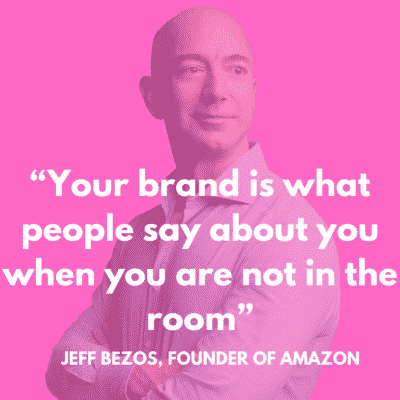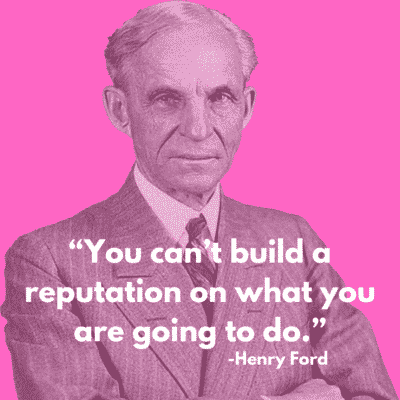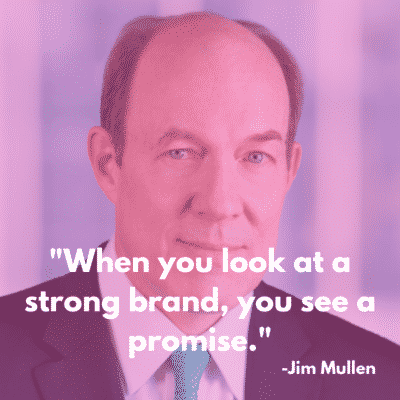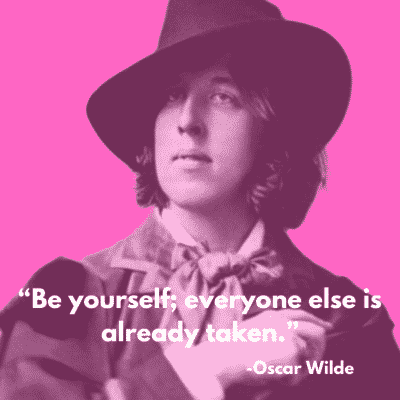When big brands decide to reinvent not only themselves but also their brand strategy, it can make for some big news.
Think of it this way, in the late ‘90s, Apple was on the verge of bankruptcy. Thanks to their biggest competitor, Microsoft, they were saved from going under.
With the help of Microsoft, it allowed Apple to shift from just being a manufacturer of Macs and reinvent itself as a creator of innovative tech products that we all know and love. Had it not been for their rebranding, they may not be around today.
The point of that little story is that sometimes, even the biggest brands need a brand strategy or need to change theirs up to succeed in today’s economy.
With that in mind, we wanted to provide you with a step-by-step guide that will help you either build your brand’s strategy or help you start the process of reinventing yourself.
Hang on tight, it’s going to be a bumpy ride.
- Related: 101+ Brand strategy resources
What is a brand?

If we’re going to be talking about brands and brand strategy, we should go over exactly what each of these are so you can understand their importance in the overall health of your business.
If you took everyone’s interpretation of what a brand is, stuck it to the wall, and threw darts at it, no matter which one you hit, you would be partly right. There are a million different definitions of the term “brand” and most of the time they’re referring to a logo printed on something to identify the business that manufactured the product.
While the logo is a part of a brand’s identity, a brand is more than just a physical mark. It’s an emotional one. To be more specific, it is an emotional experience that is strengthened or weakened depending on interactions experienced with that business.
To us, a brand is what people think, feel and say about your business. This is because what people say, feel, and think about your business can either make you a success or close your doors for good.
What is brand strategy?
Unless you’ve never played the board game Risk, having a strategy essentially means having a plan of action designed so that you can achieve a major or overall aim.
A brand strategy is a bible for your business, except it doesn’t have to be as long or subject to different interpretations. The only interpretation that counts is yours. Your brand strategy could be a one-sheet document depending on what your business offers customers.
These documents generally hold all of the information that you need to sum up what your brand is. Often this is short, sweet, and concise. While it’s not a problem if you have more to say and end up having a larger brand strategy than others but make sure that it’s in a format that everyone in the business can refer to.
To boil it down even further, a brand strategy contains all of the important information about building your brand, and what you believe in.
Why do you need a brand strategy?

Your business can suffer if you don’t know who you are, why you exist, what you believe in, or what you’re trying to achieve.
A lack of any kind of brand strategy is like having a birthday party and not the birthday boy. No one else knows why they’re there. It can also reach deep into your business from customer communication issues to even employee retention, no level of an organization is unaffected.
Don’t believe us? Let’s dig a little deeper then. Without a brand strategy…
- Your purpose, vision, mission, and values are undefined. Any decisions related to your business or marketing don’t reflect these.
- You hope that whatever you’ve been doing continues to work because you don’t have a marketing plan documented to help you succeed.
- You post inconsistent content on your website because your brand messaging isn’t cohesive and makes it even harder to attract new customers and even employees.
- Your employees don’t feel engaged or interested in the business due to a feeling of confusion, conflict, and disunity because no one understands the values of the business.
- The business never finds its “niche” because you aren’t able to articulate the brand effectively, losing customers and income.
What we’re trying to tell you is that without a brand strategy, you’re going to struggle to grow effectively.
How to bring your brand strategy to life

Despite your best effort, creating a brand strategy isn’t something you can do alone. It is absolutely a team effort to craft, revise and bring your strategy to life in every corner of your business.
These “Brand Avengers” help keep things on track. Having this team doesn’t mean you have to rush out and hire 5 new people. Your “Brand Avengers” can even be just one or two people, just as long as they can cover the essential roles.
The “Brand Avengers” lineup
To execute your brand’s strategy, five specific roles need to be filled to be successful (Roll Call!):
-
Brand Shepherd – Aligns the goals of the business with the brand
Responsible for bridging the gap between the brand and the business, the brand shepherd also communicates with higher-ups, oversee the marketing strategy for the business and they also play devil’s advocate, asking questions and poking holes in the strategy to see how it holds up.
-
Creative Lead – Preserves the brand identity
The creative lead, which can also be the brand shepherd is responsible for overseeing as well as enforcing the guidelines of the brand. This can include things like brand messaging and visual identity. They also empower the team to apply these guidelines correctly.
-
Marketing Lead – Aligns the brand strategy with marketing
The marketing lead is in charge of crafting a marketing strategy as well as overseeing content creation and they also coordinate teams as well as resources.
-
Culture Lead – Grows a culture reflective of the brand’s values
By promoting the values of the brand, the Culture Lead tries to help attract others so that they can actively participate in the building of the brand.
-
Communications Lead – Shares knowledge of the brand
A communications lead documents the information related to the brand as well as build a library for the brand. If a new employee or new CEO needs to know this information, the communications lead takes it upon himself to give the brand information to them.
What you should know before you start
When you start a new brand strategy, either from scratch or trying to do things the right way this time before you start, you need to make sure that you figure out two key pieces of information or things will just cycle back to your brand strategy failing. These are:
-
Know who your customers are
When you build a brand strategy that is designed to help you genuinely connect with people, you need to know the customers that you are trying to reach. Knowing exactly who they are and how you are trying to serve those customers can bring clarity to not only who you are but also how you can communicate with them.
-
Know who your competition is
Who are you competing against for your customer’s attention? Who shares your space and what might they do to put the focus on them instead of you.
This information is invaluable because it helps you learn who you are and who you aren’t. It shows you how you fit in or even stand out. Most importantly, it helps you learn how you can communicate your differences through your brand strategy.
How to build your brand’s strategy in 4 steps
From the outside, starting a brand strategy from scratch might seem like an impossible task. However, if you are passionate about your business and also have some idea of what you’re overall goal is then everything you need to create a brand strategy is already inside your head, waiting to come out.
The easiest way to figure everything out is to get it down on paper in a structure that makes sense to your colleagues, competitors, and most importantly, your customers.
A brand strategy document acts much in the same way that a brand guidelines document acts as a visual reference for your brand, this takes care of the strategy and high-level thinking related to your business.
To help the process, we’ve broken it down into four different, yet easily digestible parts so you have no problem learning how and then creating your brand strategy.
- Part 1: Discover the heart of your brand
- Part 2: Create your brand’s message
- Part 3: Give your brand an identity
- Part 4: Create guidelines for your brand
Let’ dive in.
Part 1: Discover the heart of your brand

Everything that a brand does is influenced by a basic set of beliefs. These beliefs are sometimes referred to as a Brand Heart. You must know what these principles are and why they matter. This is because together, they are a strong and powerful force that can either support your business and help it grow or hurt your business and possibly lead to going out of business.
When your business and the beliefs you have about your brand are lined up, the results can be outstanding. Successfully bringing people together, cultivating the community that your business is in, and being able to create the future that you want for your business are all possible.
A brand without its heart or beliefs, even if those beliefs are toxic can hurt your business in extreme ways including alienating your employees as well as customers, ruining your company’s culture, and suffering from decisions that can take your long-term goals off track.
Like our hearts, a Brand Heart (sometimes known as Brand Core or Brand DNA) is made up of four different elements that you can use to understand who you are, what you do, and most importantly, why it matters. These are:
- Purpose – What is our purpose? Why do we exist?
- Vision – What kind of future do we want to create? What does the future look like?
- Mission – How do we create the future that we see? What are we here to do?
- Values – What guides our behavior? What are our principles?
While the brand heart of your business is typically an internal document, translating that into an external-facing message and using it everywhere from your website to product packaging can have great dividends for your business.
Getting your brand heart pumping right from the beginning is key.
Part 2: Create your brand’s message

The way your brand communicates its personality and unique value proposition through verbal, as well as non-verbal messaging, is your brand’s message. This messaging can inspire and motivate customers into buying your product or service.
This message is how your customers can have a relationship with your brand. The combination of language, design, events, and more tell the story of who your brand is.
The question then becomes: “How do I start crafting brand messages my customers will love?”
To do that, you need to know two things extremely well: your target audience and unique value proposition. With these in hand, you can create a brand identity that will help your business with all of its marketing decisions.
This identity will shape the behavior of your business because you’ll learn why your brand matters, why it’s different from other brands, and what it stands for. This identity that your customers relate to and have a personality or even talks to them like a close friend, will allow you to remain relevant to customers and turn them into loyal customers.
To get started, having a full understanding of your brand’s message and the identity of your brand is important. To get a full picture though, there are steps that you need to take to create a very clear message to your customers.
Figure out who you are
For you to start creating your brand’s message, there are questions that it needs to answer before you can move forward. These questions include:
- What messages will help you connect with your target audience?
- Who is your target audience and what do they care about?
- What is your unique value proposition?
- Does your brand tell a story to your target audience?
- What are your company’s goals and values?
How are you different from your competition?
Beginning to create your brand identity and what your brand messaging looks like starts by answering the questions and remember that your brand message that every question answers the overarching question of why.
Why does your audience care? Finding out who your audience is a great way to learn why they care.
Know your audience

Once you have a better idea of who you are and what you offer your customers, the next step is to understand who your audience, namely your customers are. To do that, there are steps you can take that will help you discover a relationship between your brand and your customers. These include:
Create buyer personas
A buyer persona is a generalized, semi-fictional representation of the customers that you are hoping to serve and account for their goals, motivators, demographics, and the challenges they’re facing. These provide structure and context for your business. They can also be used to help you map out and curate content for your marketing needs, as well as other teams – such as sales and support – with time and resource allocation.
Create your brand persona
The brand persona for your business breaks down into three important categories:
- Personality
- Voice
- Tone
While these elements may seem a bit intimidating to identify, it’s not meant to be a chore. It’s meant to be something that you can discover naturally without much effort. To identify these categories, they need to be discovered and documented.
a) Discover your personality
Your brand’s human characteristics and attributes are your personalities. Your personality is a reflection of your Brand Heart. Are you curious? Enthusiastic? This personality is also influenced by your beliefs and is demonstrated in your behavior. When you understand your personality intimately, you can infuse it into your brand from customer service to product descriptions. Knowing and understanding your personality is a great way to make your brand stand out and build relationships with customers.
b) Discover your voice
The way your brand speaks and sounds is its voice. Every brand has its unique voice. Each brand speaks differently than another. A car brand and an ice cream brand speak differently and one car brand speaks differently than another. Your brand voice is already influenced by your personality and articulating it so that you can consistently communicate to people through your content.
The words, slang, jokes, and phrases that you use to communicate your identity to your customers in direct and indirect ways. You need to think about how you want to speak to your customers and how your customers want to be spoken to.
c) Discover your tone
Your general attitude is considered your tone. You may have an authoritative voice but your tone may be humble and respectful. An easy way to think of it is that the “voice” of your brand is how you talk but your “tone” is how you sound in different contexts. You might always use the same voice but depending on who you’re talking to, your tone may shift to fit the situation.
Tone can be a very difficult concept for some people to master. If your tone eludes your understanding, picture how you want to make customers feel when you’re speaking to them. Do you want to talk to them like you can help them with what they might need or do you want to come across as aloof and a little rude?
If you can discover your tone and use it correctly, it will come through in everything you do, from blog posts to Instagram stories. Some of the biggest brands in the world are excellent at this, which is why we love them and buy their products over and over again.
Benefits of a strong brand

When you start building your brand, it can be hard to see the benefits that may come from all of the time and effort that you put in. While you may not be there yet, some of the benefits that can come from creating a strong brand include:
a) Customer recognition
When a customer is shopping for an item or service, they will generally consider the one that they recognize or have had good results with. This can be beneficial to your company because if one person chooses you over another, they may recommend your product or service to someone they know increasing your recognition and boosting your business.
b) Competitive Edge
In the marketplace, your brand is what sets you apart from your competition. When customers recognize and support your brand, it can give your business a competitive edge. When you receive more recognition and use that recognition to build your brand, you’ll find that your brand grows and starts to compete against other well-known brands.
c) Customer Loyalty
Strong brands build upon the recognition that they receive from their customers and in turn, the loyalty that those customers have to your business. Customers are attracted to brands that they share values with. The strong brand that your build needs to convey those values to build an emotional connection. That brand loyalty can last a lifetime and can even transfer to future generations.
d) Credibility
Having a strong brand can increase your credibility with your customers, industry, and your marketplace as a whole. When you build your credibility, you also increase your recognition, loyalty, and competitiveness. Your credibility and everything related to that goes hand-in-hand and have a direct connection to the ease of purchase that your customers will have. Customers want to buy products and services from companies that they know, like, and trust. There is a reason companies like Ford, McDonald’s, and Jim Beam have been around for years.
Create your slogan/tagline
When you think of some of the largest brands in the world, do you picture the ins and out of their company or the slogan that they have created to encompass their brand identity?
Some of the most famous slogans include Nike’s “Just Do It” and “The happiest place on Earth”, which is the famous tagline for Disneyland. It’s not always the easiest process to create a memorable slogan that not only resonates with customers but is almost timeless and memorable.
So, how do you do it? We’re glad you asked.
a) Make it memorable
If your slogan doesn’t have a catchy ring to it, you’re already putting yourself in a tight spot. When you develop your slogan, you should try to answer these questions:
- Is it recognizable?
- Is it easy to understand?
- Is there a connection to your brand and a link between the two?
The right words that your ideal customers will be able to identify with as well as learn to associate your brand with, can have dramatic effects in helping them recall your marketing efforts such as advertisements, content posted to your blog or social media, and your products as a whole.
b) Communicate clear benefits
If you pay attention to the marketing that some products, such as weight loss, implement, you’ll notice that they focus on the results, not the details of how their programs work. This is a perfect example of a brand selling the benefits of the product, not the features.
This can work for your brand as well when you create your tagline or slogan. A great slogan can make your company (or product) benefits extremely clear to consumers.
-
Tell your story

These days, consumers are constantly talked to and sold to through all kinds of media and simply desire a genuine connection with the brands that they give their money to. Forming that connection can be challenging to say the least.
The best way to do that is by telling the story of your brand. You can humanize your brand and communicate who you are, what you do, and how you can help people. The more successful you are at doing this, the better you can stake your place and stand out in the marketplace.
The Keys to a Great Brand Story
To do this well, having an understanding of what makes your brand story stand out is essential. Essentially, it comes down to five critical elements. Do these right and your brand will be successful right from the start.
a) Give it meaning
More brands are trying to get consumer’s attention and it’s causing a lot of content burnout. Hopping on whatever marketing bandwagon that their competition is using. This causes too many brands to create what they want to create or by copying what others are doing.
The real key is to focus on what others care about. Telling a good story requires you to tell one that is interesting and relevant to the people you are trying to reach.
b) Make it personal
The stories you tell can be educational, inspiring, or even entertaining. You can tell all kinds of stories to people you are trying to reach but people need to feel a personal connection to your stories.
It’s important to not only pique their interest but to also draw them into your story. You want to be sure that you craft a story that tells them how your brand improves their life and why they should take the time to invest in your story.
If someone can’t see themselves in your story, then they won’t take the time to read it.
c) Make it emotional
A strong story about your brand is more about empathy and garnering emotions from your target audience than anything else. It’s not entirely about what you do but it’s also about how you affect people.
Let’s say your product is designed to make a task easier for people. Ultimately, the emotional hook of your brand’s story should be that it makes people’s lives easier and stress-free. It’s within that first paragraph of a blog post, the first few moments of a YouTube video, or even a podcast episode, if you can create that emotional hook, you’ll be able to reel them in every time.
d) Simplicity is key
Saying too much is one of the most common mistakes that people make when they are telling their brand’s story. Telling a simple story to make the most of the emotional attachment that you are striving to achieve rather than overwhelm people with too much.
In the 1960s, the US Navy used a principle that applies to just about everything that people tend to overthink – KISS – Keep It Simple, Stupid. While for some, this may be a bit derogatory, the idea of keeping things simple and not overthinking it is a timeless piece of advice.
When you write your brand’s story, to keep from confusing or even distracting your audience, try to focus on one person or one specific problem.
e) Be authentic
Your audience is smart. They will know if you’re being authentic and genuine with them. When you share your story, people should know that it’s your story. Not one you came up with because “it sounds good.”
Be open, honest, 100% transparent. Most importantly, let your personality illuminate the page for your reader and be consistent. Creating a ton of content without being consistent will start to cause readers to lose trust because they may not be able to identify with your changing content.
Part 3: Give your brand an identity

If you ask someone what branding is, there’s a good chance that they will tell you something has to do with the visual identity of the brand such as the logo, colors, typography, or other items that they may see as the “image” of the brand. While we know that a brand is not a logo, it certainly is a major part of any brand.
Any brand identity that succeeds is:
-
Flexible
You should be able to grow your brand with your visual identity. Whether that means offering consumers new products or breaking into a new industry, your visual identity should be able to help you get there
-
Comprehensive
Brand designers and content creators need your brand’s visual identity to be comprehensive and offer the tools that they require to do their job successfully.
-
Intuitive
Any visual identity needs to be intuitively designed and constructed well for each element to complement and benefit the other.
Your brand’s visual identity can be broken down into six fundamental parts:
Logo
Picture some of the most famous logos in the world. Many of them are memorable and if you saw them while you were driving around, you would know who they are immediately. Studies show that good logos are memorable and memorable logos keep it simple.
You want your logo to represent your brand but keeping things simple can make an impact with consumers. Another point to consider is how people will visually process your logo and assign meaning to it. Many people assign attributes to different shapes.
Typography
With consumers receiving messages across multiple mediums, the typography used with your logo & overall brand identity has never been more important. Essentially an extension of your brand, it’s important to know not only how the typography you’ve chosen aligns, but where you’ll use it.
Colors
One of the most powerful elements in nature but also in branding, color can be a mystifying element that as studies have shown, can have an impact on everything from brand perception to the intent of purchasing. A tricky process, not every color can get the same reaction. This is because each of us makes subjective associations with colors.
Imagery
With the importance of social media to not only our personal lives but also to our brand’s visual identity, imagery has never been more important. Regardless of the type of imagery you choose, be it illustration, photo, or a combination of the two, each image you use should align with your brand.
Illustrations
Developing an illustration style that is unique to your brand is a smart way to visually “brand” the content you create but be careful, it can be extremely easy to go too far. Your style should be clear, distinct, and most importantly, on-brand.
Photography
Many brands use photography in their visual branding as it is a versatile and effective tool that doesn’t take forever to design. To keep it consistent with your brand, you need to make sure you have a clear aesthetic with every photo. There are many resources available to you and numerous sources that you can choose from.
-
Stock sites
Stock sites like Unsplash or Pexels can contain numerous free, high-quality stock photographs that you can easily create design treatments that you can use to take a bland stock photo and modify it to be the voice for your brand.
-
Image licenses
Thanks to the internet, there are a wide variety of services that allow you to license photos for your brand. This can reduce the chances that your competition will be using the same images but it can still happen. Sites like Shutterstock, Adobe Stock are great choices if you want to go this route.
-
Custom photos
With the number of available creative tools, it is entirely possible to have high-quality, original photos created for your brand. Whether you hire an outside photographer to take these photos or let your internal team handle them, you need to make sure that they have the proper skills and tools to create high-resolution images that align with your brand.
Part 4: Create guidelines for your brand

Brand guidelines are the playbook for how you should use your brand or more specifically, how you can use your brand in the communication and content that you create.
It can be a challenge to maintain a level of quality as well as consistency with your content, especially if you outsource its creation to freelancers or outside agencies. This is why the guidelines for your brand should include clear enough directions so that you can empower any content creator to produce work to strengthen your brand instead of weakening it.
Including directions that ensure the guidelines for your brand are comprehensive will help both your visual and verbal identity. The strength of your brand is determined by the consistency it portrays or lack thereof. The guidelines you create should cover the following areas:
Non-visual guidelines
- Brand persona (voice, personality, tone)
- Slogan
- Value prop
- Messaging pillars
- Anything else helpful or relevant
Visual guidelines
- Logo
- Color
- Typography
- Imagery
- Hierarchy
- Iconography
- Data visualization
- Interactive elements
- Video and motion
Bring it all together and give your brand life!
So, you’ve gone through the entire process of creating a strategy for your brand, you can now take a long-deserved rest… just kidding. You must continue to evolve and grow your brand! With all of the work you put into creating a brand strategy, all of the tools you need to effectively communicate your brand story, align your brand and your business, plus how to start building relationships that will not only last but help contribute to your long-term success.
The downside? Just cause you made it this far doesn’t mean the work stops. Going forward, to implement your brand strategy effectively, you need to focus on the following:
- Keep up on best practices
- Create brand-aligned content
- Master your content creation
- At every touchpoint, tell your brand story
- Maximize the reach of your content & message
This can be a lot for any entrepreneur or brand team to take on, especially if you’re a small team with a shortage of time or resources. You may want to consider bringing in outside help. Finding a creative agency can make the whole process easier and allow you to focus on more important aspects of your business.
We hope our guide on how to create a brand strategy has helped give you some insight on how the right strategy can make your brand stand out – not only among your competition but also with your customers and help you earn long-term success.
The post The Ultimate Guide to Brand Strategy first appeared on JUST™ Creative.
No comments:
Post a Comment